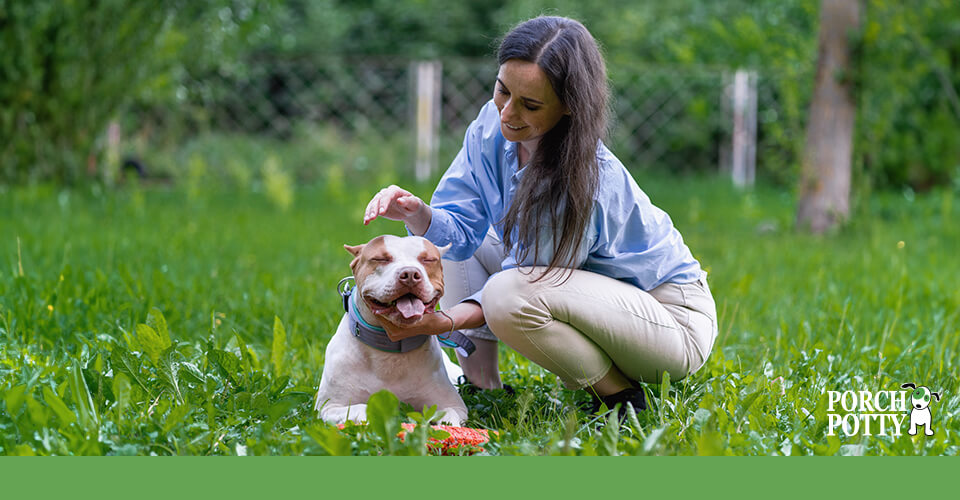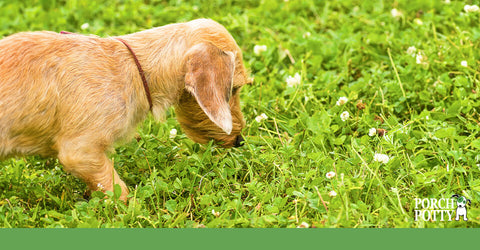
A big Pitbull puppy and its owner enjoy the bright green grass and sunshine in their backyard.
Bringing a new puppy into your life is an adventure filled with joy, bonding, and the inevitable challenge of potty training. For new pet owners, especially those in urban environments or apartments, the task of potty training can seem particularly daunting. This guide aims to demystify the process, offering a detailed roadmap to identify the perfect age and signs of readiness for potty training your puppy, alongside introducing best practices and the revolutionary role of Porch Potty in making potty training more manageable and effective.
The journey to a well-trained pup begins with a crucial element: timing. Starting too early or too late can complicate the training process, but armed with the correct knowledge and tools, you can pave the way for a smooth training experience. This guide is your ally, providing you with the insights needed to embark on this pivotal journey with confidence.
Understanding Puppy Development
Understanding puppy development is key to successfully navigating various training and care aspects, including potty training.
Physical Development
- Puppies are born blind and deaf, depending entirely on their mother for care.
- Most puppies open their eyes and start to hear by the age of 2-3 weeks.
- Teething begins around 3-4 weeks, and puppies start to eat solid food.
- By 6-8 weeks, puppies are weaned and should start receiving vaccinations.
- Physical control over bladder and bowels starts improving significantly around 12-16 weeks, making it an optimal time to begin potty training.
Behavioral Development
- Socialization Period (3-14 weeks): Puppies learn to interact with other dogs and humans. Exposure to various people, animals, and environments during this time is crucial for developing well-adjusted behaviors.
- Fear Periods: The first fear period occurs around 8-11 weeks. It's important to avoid negative experiences during this time, as they can have lasting effects on a puppy's behavior.
- Play: Play and exploration drive peak around 4-5 months of age, requiring consistent, positive training sessions to instill good habits.
Cognitive Development
- Puppies start learning from their environment right after birth, with significant cognitive development happening between 3-16 weeks.
- They learn through play, observation, and interaction with their environment and littermates.
- This period is crucial for introducing basic commands and positive reinforcement to shape desired behaviors.
Emotional Development
- Puppies form strong bonds with their owners and can start showing signs of separation anxiety if not properly managed.
- Positive social experiences during early development stages are essential for emotional stability and prevent fearfulness or aggression later in life.
Puppies generally show readiness for potty training between 12 to 16 weeks. This period is significant because it marks the point at which they begin to gain control over their bladder and bowels. However, every puppy is an individual, and readiness can vary. Observing your puppy for developmental readiness signs is more crucial than adhering to a strict age guideline.
Puppy development is multifaceted, encompassing physical and behavioral growth. Understanding these stages is essential for a successful potty training experience. For instance, a puppy’s ability to hold their bladder increases with age, which means that a 16-week-old puppy might hold it for longer periods than a 12-week-old.

A yellow puppy sniffs the ground, trying to find just the right spot to potty.
Recognizing Readiness Signs
Identifying the right time to start potty training involves watching for specific readiness signs in your puppy’s behavior. These signs might include:
- Developing a preference for certain spots to relieve themselves.
- Being able to hold their bladder for increasingly longer periods.
- Showing pre-potty behavior such as circling, sniffing, or showing restlessness, which indicates they’re searching for a place to go.
Understanding and recognizing these signs are your green light to begin potty training with a blend of patience and enthusiasm.
Initial Steps in Potty Training
- Establish a Routine: Dogs thrive on routine. Set specific times for feeding, potty breaks, play, and sleep. This helps your puppy learn when it’s time to go to the bathroom. Typically, puppies need to relieve themselves upon waking up, after playing, and after eating or drinking.
- Choose the Potty Area Wisely: Decide on a specific spot outside where you want your puppy to go. Always take them to this spot when it's time for a potty break. This helps your puppy associate this area with going to the bathroom.
- Frequent Breaks: Puppies have small bladders and will need to go out frequently. Take them out at least every two hours, as well as immediately after they wake up, during and after playing, and after eating or drinking.
- Use a Cue Word: When you take your puppy to the potty area, use a consistent word or phrase like "go potty" to help them associate the command with the action. Over time, this cue will help your puppy understand what is expected when taken to their spot.
- Praise and Reward: Immediately after your puppy goes potty in the correct area, praise them and offer a treat. This positive reinforcement helps them understand that they’ve done something good.
- Supervise Indoors: When indoors, keep an eye on your puppy for signs that they need to go potty, such as sniffing around, whining, or circling. If you catch them in the act, immediately take them outside to their potty area.
- Use a Crate: Crates can be a useful tool in potty training, as dogs naturally avoid soiling their sleeping area. Ensure the crate is the right size—big enough for the puppy to stand, turn around, and lie down but not so large that they can use one end as a bathroom. Crate training should be done in steps to ensure the puppy feels safe and secure.
- Accidents Happen: Understand that accidents are part of the process. If you catch your puppy in the act, calmly take them outside to finish. Avoid punishing your puppy for accidents, as this can lead to fear and confusion. Instead, clean up accidents with an enzymatic cleaner to remove the scent and discourage future marking in that area.
- Consistency is Key: Everyone in the household should follow the same training steps and routines to avoid confusing your puppy.
- Patience: Remember that potty training is a process. It might take several weeks or months, depending on the puppy. Stay patient and consistent, and celebrate the small successes along the way.
By following these initial steps, you’re laying the foundation for a well-trained puppy. It’s important to remember that every puppy is different, and what works for one may not work for another. Adapt your training to fit your puppy’s personality and needs, and always approach potty training with a positive attitude.
Utilizing Porch Potty
In the urban jungle, green spaces are often a luxury. For apartment dwellers, Porch Potty is a game-changer. It mimics an outdoor environment, offering a grassy area where your puppy can relieve themselves comfortably. This not only maintains cleanliness in your living space but also caters to your puppy’s natural instincts, facilitating a smoother training process.
Integrating Porch Potty into your training regimen is straightforward. Place it in a designated area and lead your puppy to it during potty breaks. This consistency helps your puppy associate the Porch Potty with going to the bathroom, streamlining the training process.

A cute tiny puppy enjoys some cuddles while playing with its owner in the backyard.
Overcoming Common Obstacles
Potty training is a journey filled with ups and downs. Accidents are a natural part of the learning process, and it’s crucial to approach them with understanding rather than frustration. Punishing your puppy for accidents can lead to anxiety and fear, which can actually hinder the training process.
- Regression: Sometimes, a puppy that seemed to have mastered potty training may start having accidents again. This can be due to various factors, including changes in the environment, stress, or health issues. It’s important to approach regression with patience, revisiting the basics of potty training if necessary.
- Stubbornness: Some puppies may seem resistant to training. In these cases, it might be necessary to adjust your approach. For example, increasing the frequency of potty breaks or using more enticing rewards for successful outings can help.
- Adapting to Urban Living: For puppies in urban settings, adapting to potty training can be especially challenging. The lack of immediate outdoor access means relying more heavily on solutions like Porch Potty. Successfully training your puppy in an urban environment requires extra patience and consistency but is entirely achievable with the right approach.
Potty training your puppy is a significant milestone that requires patience, consistency, and the right approach. By understanding your puppy’s development, recognizing readiness signs, and utilizing innovative tools like Porch Potty, you can navigate the potty training journey successfully. Remember, every puppy is unique, and flexibility in your approach can make a big difference.
We encourage you to share your potty training adventures, questions, and insights. Exploring Porch Potty products can offer additional support as you train your new furry family member. Your journey with your puppy is a learning experience filled with opportunities for growth and bonding. Together, we can make potty training a positive and successful endeavor.
For more information on training your puppy, check out these articles:
When To Start Potty Training a Puppy: How Old Should a Puppy Be?



